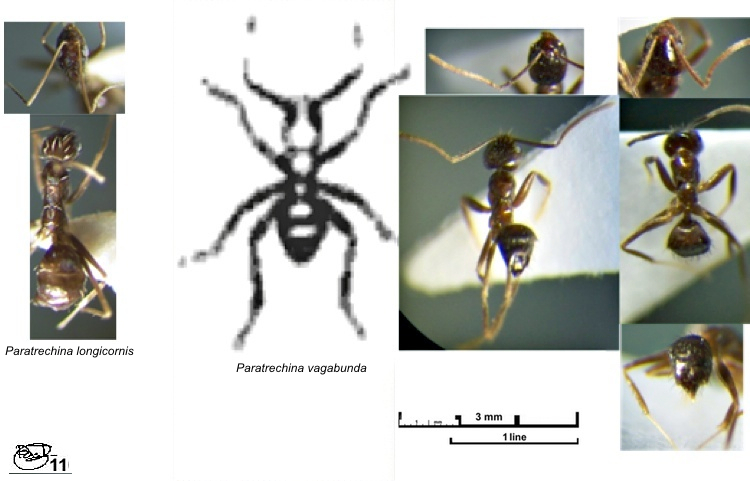 Motschoulsky's (1863) description is at Motschoulsky's (1863) description is at  . .
I translate the French description of the new Genus as:
Very close to Tapinoma,
but the clypeus with an arcuate anterior margin without any incision,
antennae more linear (narrow?), with the first segment of the funiculus
longer than the second, alitrunk (mesosoma) terminated posteriorly by
two more or less raised tubercles, gaster triangularly acuminate behind
and covered with long hairs that are sparse as on the rest of the body.
Head without ocelli.
With the aid of Dr & Mrs Francis Gilbert, my
translation from the Latin, of Paratrichina
vagabunda
MOTSCHOULSKY is: TL 2.54 mm (1 line = 2.117 mm), HW 0.53 mm,
subelongate, dark erect hairs, piceous, legs femora and tarsi
testaceous white; eyes black, oblong and flat, placed on top of the
head; head oblong, raised laterally (transversely) between the
antennae, clypeus convex, semilunate, without a median carina; antennae
slightly shorter than the body, first segment of the funiculus longer
than the second; alitrunk (mesosoma) narrower than the head,
subelongate, medially constricted, posteriorly gibbous (humped or
dome-shaped), apex bituberculate to bilobed; petiole scale oblong;
gaster ovate, slightly wider than the head, shiny, hairy, apex
acuminate; tarsi moderate. From the Patannas Mountains (Ceylon).
Then, translating again from the French: A second
smaller species, more slender and of a lighter colour on the alitrunk
and legs is not rare (uncommon) on the plants in our hot houses [he
lived in Moscow] and I have named this Paratr. currens. (BOLTON, 1995:
313, erroneously listed the type location as Sri Lanka).
A native French speaker, Dr Philippe Annoyer, feels that
MOTSCHOULSKY used "je l'ai nommée" because he had observed the second
species many times before and had thought of the name currens well before writing the
paper. Philippe suggests the name may spring from the species running
quickly.
Arguably, MOTSCHOULSKY included the species as an aside
because it fitted his new genus.
MOTSCHOULSKY (1868) listed all the insect species he
had described. On page 65 the entry is as follows: Paratrechina B. 1863, III, p. 13. vagabunda. Ceylan. B. 1863, III,
p.13. currens. Ind. or. B.
1863, III, p.14.
This shows a) the priority of the species names and b) that there was
no earlier publication of the name currens.
Although there is a similarity to Paratrechina bourbonica that
has dense pubescence
on the mesopleuron (type images from Antweb) and has a dull appearance. This has none and has a distinctly more
rounded head in full face view. The illustration compares Paratrechina longicornis (left),
the Motschoulsky illustration (centre) and the fresh vagabunda (right). Also from Sri Lanka is Paratrechina yerburyi (Forel, 1894c: 409) but that is larger and readily separated from vagabunda - see http://www.antweb.org/specimenImages.do?code=casent0911013.
|